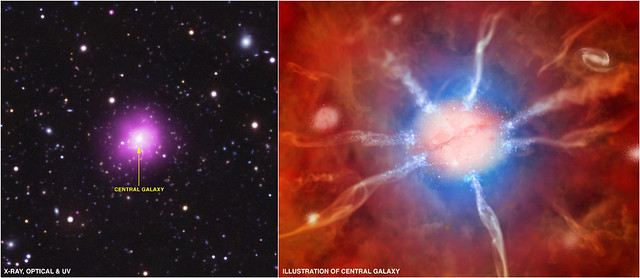Galaxy Cluster SPT-CLJ2344-4243
Thursday, August 16th, 2012
That’s not a very compelling title for a fascinating post. Unless your one of the many astronomers who worked on this new discovery by the Chandra X-Ray Observatory…
Astronomers have found an extraordinary galaxy cluster, one of the largest objects in the universe, that is breaking several important cosmic records. Observations of the Phoenix cluster with NASA’s Chandra X-ray Observatory, the National Science Foundation’s South Pole Telescope, and eight other world-class observatories may force astronomers to rethink how these colossal structures and the galaxies that inhabit them evolve.
Stars are forming in the Phoenix cluster at the highest rate ever observed for the middle of a galaxy cluster. The object also is the most powerful producer of X-rays of any known cluster and among the most massive. The data also suggest the rate of hot gas cooling in the central regions of the cluster is the largest ever observed.
The Phoenix cluster is located about 5.7 billion light years from Earth. It is named not only for the constellation in which it is located, but also for its remarkable properties.
“While galaxies at the center of most clusters may have been dormant for billions of years, the central galaxy in this cluster seems to have come back to life with a new burst of star formation,” said Michael McDonald, a Hubble Fellow at the Massachusetts Institute of Technology and the lead author of a paper appearing in the Aug. 16 issue of the journal Nature. “The mythology of the Phoenix, a bird rising from the dead, is a great way to describe this revived object.”
Like other galaxy clusters, Phoenix contains a vast reservoir of hot gas, which itself holds more normal matter — not dark matter — than all of the galaxies in the cluster combined. This reservoir can be detected only with X-ray telescopes such as Chandra. The prevailing wisdom once had been that this hot gas should cool over time and sink to the galaxy at the center of the cluster, forming huge numbers of stars. However, most galaxy clusters have formed very few stars during the last few billion years. Astronomers think the supermassive black hole in the central galaxy of a cluster pumps energy into the system, preventing cooling of gas from causing a burst of star formation.